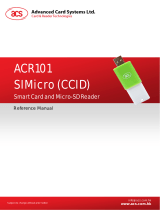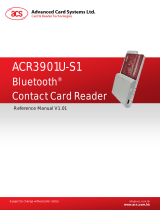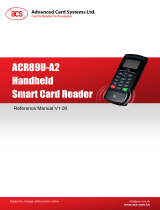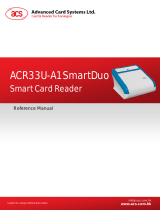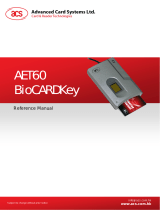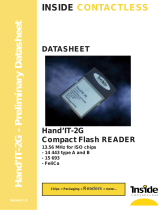Page is loading ...

Subject to change without prior notice info@acs.com.hk
www.acs.com.hk
Reference Manual V2.01
ACR3801
PC-linked
Smart Card Reader
FIPS 201 Certified

ACR3801 – Reference Manual info@acs.com.hk
Version 2.01
www.acs.com.hk
Page 2 of 62
Table of Contents
1.0. Introduction ............................................................................................................. 4
1.1. Reference Documents ........................................................................................................... 4
1.2. Symbols and Abbreviations ................................................................................................... 4
2.0. Features ................................................................................................................... 5
3.0. Supported Card Types ............................................................................................ 6
3.1. MCU Cards ............................................................................................................................ 6
3.2. Memory-based Smart Cards.................................................................................................. 6
4.0. Smart Card Interface ............................................................................................... 7
4.1. Smart Card Power Supply VCC (C1) .................................................................................... 7
4.2. Programming Voltage VPP (C6) ............................................................................................ 7
4.3. Card Type Selection .............................................................................................................. 7
4.4. Interface for Microcontroller-based Cards ............................................................................. 7
4.5. Card Tearing Protection ......................................................................................................... 7
5.0. Power Supply ........................................................................................................... 8
5.1. Status LED ............................................................................................................................. 8
6.0. USB Interface ........................................................................................................... 9
6.1. Communication Parameters .................................................................................................. 9
6.2. Endpoints ............................................................................................................................... 9
7.0. Communication Protocol ...................................................................................... 10
8.0. Commands ............................................................................................................. 12
8.1. CCID Command Pipe Bulk-OUT Messages ........................................................................ 12
8.1.1. PC_to_RDR_IccPowerOn ........................................................................................... 12
8.1.2. PC_to_RDR_IccPowerOff ........................................................................................... 13
8.1.3. PC_to_RDR_GetSlotStatus ........................................................................................ 14
8.1.4. PC_to_RDR_XfrBlock ................................................................................................. 15
8.1.5. PC_to_RDR_GetParameters ...................................................................................... 16
8.1.6. PC_to_RDR_ResetParameters .................................................................................. 17
8.1.7. PC_to_RDR_SetParameters ...................................................................................... 18
8.2. CCID Bulk-IN Messages ...................................................................................................... 20
8.2.1. RDR_to_PC_DataBlock .............................................................................................. 20
8.2.2. RDR_to_PC_SlotStatus .............................................................................................. 21
8.2.3. RDR_to_PC_Parameters ............................................................................................ 22
8.3. Memory Card Command Set ............................................................................................... 23
8.3.1. Recollection Card – 1, 2, 4, 8 and 18 Kbit I2C Card ................................................... 23
8.3.2. Memory Card – 32, 64, 128, 256, 512, and 1024 Kbit I2C Card ................................ 26
8.3.3. Memory Card – ATMEL AT88SC153.......................................................................... 29
8.3.4. Memory Card – ATMEL AT88C1608 .......................................................................... 32
8.3.5. Memory Card – SLE 4418/SLE 4428/SLE 5518/SLE 5528 ........................................ 36
8.3.6. Memory Card – SLE 4432/SLE 4442/SLE 5532/SLE 5542 ........................................ 41
8.3.7. Memory Card – SLE 4406/SLE 4436/SLE 5536/SLE 6636 ........................................ 46
8.3.8. Memory Card – SLE 4404 .......................................................................................... 50
8.3.9. Memory Card – AT88SC101/AT88SC102/AT88SC1003 ........................................... 54
8.4. Other Commands Access via PC_to_RDR_XfrBlock .......................................................... 60
8.4.1. GET_READER_INFORMATION ................................................................................ 60
Appendix A. Supported Card Types .............................................................................. 61
Appendix B. Response Error Codes ............................................................................. 62

ACR3801 – Reference Manual info@acs.com.hk
Version 2.01
www.acs.com.hk
Page 3 of 62
List of Tables
Table 1 : Symbols and Abbreviations ..................................................................................................... 4
Table 2 : USB Interface Wiring ............................................................................................................... 9
Table 3 : Supported Card Types .......................................................................................................... 61
Table 4 : Response Error Codes .......................................................................................................... 62

ACR3801 – Reference Manual info@acs.com.hk
Version 2.01
www.acs.com.hk
Page 4 of 62
1.0. Introduction
ACR3801 Smart Card Reader acts as a communication interface between a computer and a smart
card. Different types of smart cards have different commands and different communication protocols,
which prevents in most cases, the direct communication between a smart card and a computer. The
ACR3801 Smart Card Reader establishes a uniform interface from the computer to the smart card for
a wide variety of cards. By taking care of the card specifics, it liberates the computer software
programmer of getting involved with the technical details of the smart card operation, which are in
many cases irrelevant to the implementation of a smart card system.
1.1. Reference Documents
The following related documents are available from www.usb.org
• Universal Serial Bus Specification 2.0 (also referred to as the USB specification), April 27,
2000
• Universal Serial Bus Common Class Specification 1.0, December 16, 1997
• Universal Serial Bus Device Class: Smart Card CCID Specification for Integrated Circuit(s)
Cards Interface Devices, Revision 1.1, April 22, 2005
The following related documents can be ordered through www.ansi.org
• ISO/IEC 7816-1; Identification Cards – Integrated circuit(s) cards with contacts - Part 1:
Physical Characteristics
• ISO/IEC 7816-2; Identification Cards – Integrated circuit(s) cards with contacts - Part 2:
Dimensions and Locations of the contacts
• ISO/IEC 7816-3; Identification Cards – Integrated circuit(s) cards with contacts - Part 3:
Electronic signals and transmission protocols
1.2. Symbols and Abbreviations
Abbreviation Description
ATR Answer-to-reset
CCID Chip/Smart Card Interface Device
ICC Integrated Circuit Cards
IFSC Information Field Sized for ICC for protocol T=1
IFSD Information Field Sized for CCID for protocol T=1
NAD Node Address
PPS Protocol and Parameters Selection
RFU Reserved for future use*
TPDU Transport Protocol Data Unit
USB Universal Serial Bus
Table 1: Symbols and Abbreviations
*Note: Must be set to zero unless stated differently.

ACR3801 – Reference Manual info@acs.com.hk
Version 2.01
www.acs.com.hk
Page 5 of 62
2.0. Features
• USB 2.0 Full Speed Interface
• Plug-and-Play – CCID support brings utmost mobility
• Smart Card Reader:
o Supports ISO 7816 Class A, B and C (5 V, 3 V, 1.8 V) cards
o Supports CAC (Common Access Card)
o Supports microprocessor cards with T=0 or T=1 protocol
o Supports memory cards
o Supports PPS (Protocol and Parameters Selection)
o Features Short Circuit Protection
• Application Programming Interface:
o Supports PC/SC
o Supports CT-API (through wrapper on top of PC/SC)
• Supports Android™ OS 3.1 and above
• Compliant with the following standards:
o FIPS 201
o TAA
o EN60950/IEC 60950
o ISO 7816
o CE
o FCC
o PC/SC
o CCID
o Microsoft WHQL
o RoHS

ACR3801 – Reference Manual info@acs.com.hk
Version 2.01
www.acs.com.hk
Page 6 of 62
3.0. Supported Card Types
3.1. MCU Cards
ACR3801 is a PC/SC compliant smart card reader that supports ISO 7816 Class A, B and C (5 V, 3 V,
and 1.8 V) smart cards. It also works with MCU cards following either the T=0 and T=1 protocol.
The card ATR indicates the specific operation mode (TA2 present; bit b5 of TA2 must be 0) and when
that particular mode is not supported by ACR3801, the reader will reset the card to a negotiable
mode. If the card cannot be set to negotiable mode, the reader will then reject the card.
When the card ATR indicates the negotiable mode (TA2 not present) and communication parameters
other than the default parameters, the ACR3801 will execute the PPS and try to use the
communication parameters that the card suggested in its ATR. If the card does not accept the PPS,
the reader will use the default parameters (F=372, D=1).
For the meaning of the aforementioned parameters, please refer to ISO 7816-3.
3.2. Memory-based Smart Cards
ACR3801 works with several memory-based smart cards such as:
• Cards following the I2C bus protocol (free memory cards) with maximum 128 bytes page with
capability, including:
o Atmel: AT24C01/02/04/08/16/32/64/128/256/512/1024
o SGS-Thomson: ST14C02C/4C
o Gemplus: GFM1K to 8K
• Cards with secure memory IC with password and authentication, including:
o Atmel: AT88SC153 and AT88SC1608
• Cards with intelligent 1k bytes EEPROM with write-protect function, including:
o Infineon: SLE4418, SLE4428, SLE5518 and SLE5528
• Cards with intelligent 256 bytes EEPROM with write-protect function, including:
o Infineon: SLE4432, SLE4442, SLE5532 and SLE5542
• Cards with ‘104’ type EEPROM non-reloadable token counter cards, including:
o Infineon: SLE4406, SLE4436, SLE5536 and SLE6636
• Cards with Intelligent 416-Bit EEPROM with internal PIN check, including:
o Infineon: SLE4404
• Cards with Security Logic with Application Zone(s), including:
o Atmel: AT88SC101, AT88SC102, AT88SC1003

ACR3801 – Reference Manual info@acs.com.hk
Version 2.01
www.acs.com.hk
Page 7 of 62
4.0. Smart Card Interface
The interface between the ACR3801 and the inserted smart card follows the specification of ISO
7816-3 with certain restrictions or enhancements to increase the practical functionality of ACR3801.
4.1. Smart Card Power Supply VCC (C1)
The current consumption of the inserted card must not be higher than 50 mA.
4.2. Programming Voltage VPP (C6)
According to ISO 7816-3, the smart card contact C6 (VPP) supplies the programming voltage to the
smart card. Since all common smart cards in the market are EEPROM-based and do not require the
provision of an external programming voltage, the contact C6 (VPP) has been implemented as a
normal control signal in the ACR3801. The electrical specifications of this contact are identical to
those of the signal RST (at contact C2).
4.3. Card Type Selection
The controlling PC must always select the card type through the proper command sent to the
ACR3801 prior to activating the inserted card. This includes both the memory cards and MCU-based
cards.
For MCU-based cards, the reader allows to select the preferred protocol, T=0 or T=1. However, this
selection is only accepted and carried out by the reader through the PPS when the card inserted in
the reader supports both protocol types. Whenever an MCU-based card supports only one protocol
type, T=0 or
T=1, the reader automatically uses that protocol type, regardless of the protocol type
selected by the application.
4.4. Interface for Microcontroller-based Cards
For microcontroller-based smart cards, only the contacts C1 (VCC), C2 (RST), C3 (CLK), C5 (GND)
and C7 (I/O) are used. A frequency of 4 MHz is applied to the CLK signal (C3).
4.5. Card Tearing Protection
ACR3801 provides a mechanism to protect the inserted card when it is suddenly withdrawn while it is
powered up. The power supply to the card and the signal lines between the ACR3801 and the card is
immediately deactivated when the card is being removed. However, as a rule to avoid any electrical
damage, a card should only be removed from the reader while it is powered down.
Note: ACR3801 never switches on the power supply to the inserted card by itself. The controlling
computer through the proper command sent to the reader must explicitly do this.

ACR3801 – Reference Manual info@acs.com.hk
Version 2.01
www.acs.com.hk
Page 8 of 62
5.0. Power Supply
ACR3801 requires a voltage of 5 V DC, 100 mA, regulated, power supply. ACR3801 gets the power
supply from the computer (through the cable supplied along with each type of reader).
5.1. Status LED
The LED indicates the activation status of the smart card interface:
• Flashing slowly (turns on 200 ms for every 2 seconds)
Indicates ACR3801 is powered up and in the standby state. Either the smart card has not
been inserted or the smart card has not been powered up (if it is inserted).
• Lighting up
Indicates power supply to the smart card is switched on, i.e., the smart card is activated.
• Flashing quickly
Indicates there are communications between ACR3801 and smart card.

ACR3801 – Reference Manual info@acs.com.hk
Version 2.01
www.acs.com.hk
Page 9 of 62
6.0. USB Interface
6.1. Communication Parameters
ACR3801 is connected to a computer through USB as specified in the USB Specification 2.0.
ACR3801 is working in full speed more, i.e. 12 Mbps.
Pin Signal Function
1 VBUS +5 V power supply for the reader
2 D- Differential signal transmits data between ACR3801 and PC
3 D+ Differential signal transmits data between ACR3801 and PC
4 GND Reference voltage level for power supply
Table 2: USB Interface Wiring
Note: In order for the ACR3801 to function properly through USB interface, either ACS proprietary
device driver or the ACS PC/SC device driver has to be installed.
6.2. Endpoints
ACR3801 uses the following endpoints to communicate with the host computer:
Control Endpoint
For setup and control purpose
Bulk OUT
For command to be sent from host to ACR3801
(data packet size is 64 bytes)
Bulk IN
For response to be sent from ACR3801 to host
(data packet size is 64 bytes)
Interrupt IN
For card status message to sent from ACR3801 to host
(data packet size is 8 bytes)

ACR3801 – Reference Manual info@acs.com.hk
Version 2.01
www.acs.com.hk
Page 10 of 62
7.0. Communication Protocol
ACR3801 shall interface with the host through the USB connection. A specification, namely CCID, has
been released within the industry defining such a protocol for the USB chip-card interface devices.
CCID covers all the protocols required for operating smart cards.
The configurations and usage of USB endpoints on ACR3801 shall follow CCID Section 3.
An overview is summarized below:
1. Control Commands are sent on control pipe (default pipe). These include class-specific
requests and USB standard requests. Commands that are sent on the default pipe report
information back to the host on the default pipe.
2. CCID Events are sent on the interrupt pipe.
3. CCID Commands are sent on BULK-OUT endpoint. Each command sent to ACR3801 has an
associated ending response. Some commands can also have intermediate responses.
4. CCID Responses are sent on BULK-IN endpoint. All commands sent to ACR3801 have to be
sent synchronously (e.g., bMaxCCIDBusySlots is equal to 01h for ACR3801).
ACR3801 supported CCID features are indicated in its Class Descriptor:
Offset Field Size Value Description
0
bLength
1 36h Size of this descriptor, in bytes
1
bDescriptorType
1 21h CCID Functional Descriptor type
2
bcdCCID
2 0100h
CCID Specification Release Number in
Binary-Coded decimal
4
bMaxSlotIndex
1 00h One slot is available on ACR3801
5
bVoltageSupport
1 07h
ACR3801 can supply 1.8 V, 3 V, and
5 V to its slot
6
dwProtocols
4 00000003h
ACR3801 supports T=0 and T=1
protocol
10
dwDefaultClock
4 00000FA0h Default ICC clock frequency is 4 MHz
14
dwMaximumClock
4 00000FA0h
Maximum supported ICC clock
frequency is 4 MHz
18
bNumClockSupported
1 00h
Does not support manual setting of
clock frequency
19
dwDataRate
4 00002A00h Default ICC I/O data rate is 10752 bps
23
dwMaxDataRate
4 0001F808h
Maximum supported ICC I/O data rate is
344 kbps
27
bNumDataRatesSupported
1 00h
Does not support manual setting of data
rates
28
dwMaxIFSD
4 00000FEh
Maximum IFSD supported by ACR3801
for protocol T=1 is 254
32
dwSynchProtocols
4 00000000h
ACR3801 does not support synchronous
card
36
dwMechanical
4 00000000h
ACR3801 does not support special
mechanical characteristics

ACR3801 – Reference Manual info@acs.com.hk
Version 2.01
www.acs.com.hk
Page 11 of 62
Offset Field Size Value Description
40
dwFeatures
4 00010030h
ACR3801 supports the following
features:
Automatic ICC clock frequency change
according to parameters
Automatic baud rate change according
to frequency and FI,DI parameters
TPDU level change with ACR3801
44
dwMaxCCIDMessageLength
4 0000010Fh
Maximum message length accepted by
ACR3801 is 271 bytes
48
bClassGetResponse
1 00h Insignificant for TPDU level exchanges
49
bClassEnvelope
1 00h Insignificant for TPDU level exchanges
50
wLCDLayout
2 0000h No LCD
52
bPINSupport
1 00h No PIN Verification
53
bMaxCCIDBusySlots
1 01h Only 1 slot can be simultaneously busy

ACR3801 – Reference Manual info@acs.com.hk
Version 2.01
www.acs.com.hk
Page 12 of 62
8.0. Commands
8.1. CCID Command Pipe Bulk-OUT Messages
ACR3801 shall follow the CCID Bulk-OUT Messages as specified in CCID Section 4. In addition, this
specification defines some extended commands for operating additional features.
This section lists the CCID Bulk-OUT Messages to be supported by ACR3801.
8.1.1. PC_to_RDR_IccPowerOn
Activates the card slot and returns ATR from the card.
Offset Field Size Value Description
0
bMessageType
1 62h -
1
dwLength
4 00000000h Size of extra bytes of this message
2
bSlot
1 -
Identifies the slot number for this
command
5
bSeq
1 - Sequence number for command
6
bPowerSelect
1 -
Voltage that is applied to the ICC:
00h = Automatic Voltage Selection
01h = 5 volts
02h = 3 volts
7
abRFU
2 - Reserved for future use
The response to this command message is the RDR_to_PC_DataBlock response message and the
data returned is the Answer-to-Reset (ATR) data.

ACR3801 – Reference Manual info@acs.com.hk
Version 2.01
www.acs.com.hk
Page 13 of 62
8.1.2. PC_to_RDR_IccPowerOff
Deactivates the card slot.
Offset Field Size Value Description
0
bMessageType
1 63h -
1
dwLength
4 00000000h Size of extra bytes of this message
5
bSlot
1 -
Identifies the slot number for this
command
6
bSeq
1 - Sequence number for command
7
abRFU
3 - Reserved for future use
The response to this message is the RDR_to_PC_SlotStatus message.

ACR3801 – Reference Manual info@acs.com.hk
Version 2.01
www.acs.com.hk
Page 14 of 62
8.1.3. PC_to_RDR_GetSlotStatus
Gets current status of the slot.
Offset Field Size Value Description
0
bMessageType
1 65h -
1
dwLength
4 00000000h Size of extra bytes of this message
5
bSlot
1 -
Identifies the slot number for this
command
6
bSeq
1 - Sequence number for command
7
abRFU
3 - Reserved for future use
The response to this message is the RDR_to_PC_SlotStatus message.

ACR3801 – Reference Manual info@acs.com.hk
Version 2.01
www.acs.com.hk
Page 15 of 62
8.1.4. PC_to_RDR_XfrBlock
Transfers data block to the ICC.
Offset Field Size Value Description
0
bMessageType
1 6Fh -
1
dwLength
4 -
Size of abData field of this message
5
bSlot
1 -
Identifies the slot number for this
command
6
bSeq
1 - Sequence number for command
7
bBWI
1 -
Used to extend the CCIDs Block
Waiting Timeout for this current
transfer. The CCID will timeout the
block after “this number multiplied by
the Block Waiting Time” has expired.
8
wLevelParameter
2 0000h RFU (TPDU exchange level)
10
abData
Byte
array
-
Data block sent to the CCID. Data is
sent “as is” to the ICC (TPDU
exchange level).
The response to this message is the RDR_to_PC_DataBlock message.

ACR3801 – Reference Manual info@acs.com.hk
Version 2.01
www.acs.com.hk
Page 16 of 62
8.1.5. PC_to_RDR_GetParameters
Gets slot parameters.
Offset Field Size Value Description
0
bMessageType
1 6Ch -
1
DwLength
4 00000000h Size of extra bytes of this message
5
BSlot
1 -
Identifies the slot number for this
command
6
BSeq
1 - Sequence number for command
7
AbRFU
3 - Reserved for future use
The response to this message is the RDR_to_PC_Parameters message.

ACR3801 – Reference Manual info@acs.com.hk
Version 2.01
www.acs.com.hk
Page 17 of 62
8.1.6. PC_to_RDR_ResetParameters
Resets slot parameters to default value.
Offset Field Size Value Description
0
bMessageType
1 6Dh -
1
DwLength
4 00000000h Size of extra bytes of this message
5
BSlot
1 -
Identifies the slot number for this
command
6
BSeq
1 - Sequence number for command
7
AbRFU
3 - Reserved for future use
The response to this message is the RDR_to_PC_Parameters message.

ACR3801 – Reference Manual info@acs.com.hk
Version 2.01
www.acs.com.hk
Page 18 of 62
8.1.7. PC_to_RDR_SetParameters
Sets slot parameters.
Offset Field Size Value Description
0
bMessageType
1 61h -
1
dwLength
4 - Size of extra bytes of this message
5
bSlot
1 -
Identifies the slot number for this
command
6
bSeq
1 - Sequence number for command
7
bProtocolNum
1 -
Specifies what protocol data structure
follows:
00h = Structure for protocol T=0
01h = Structure for protocol T=1
The following values are reserved for
future use:
80h = Structure for 2-wire protocol
81h = Structure for 3-wire protocol
82h = Structure for I2C protocol
8
abRFU
2 - Reserved for future use
10
abProtocolDataStructure
Byte
array
- Protocol Data Structure
Protocol Data Structure for Protocol T=0 (dwLength=00000005h)
Offset Field Size Value Description
10
bmFindexDindex
1 -
B7-4 – FI – Index into the table 7 in
ISO/IEC 7816-3:1997 selecting a
clock rate conversion factor
B3-0 – DI - Index into the table 8 in
ISO/IEC 7816-3:1997 selecting a baud
rate conversion factor
11
bmTCCKST0
1 -
B0 – 0b, B7-2 – 000000b
B1 – Convention used (b1=0 for direct,
b1=1 for inverse) Note: The CCID
ignores this bit.
12
bGuardTimeT0
1 -
Extra Guardtime between two
characters. Add 0 to 254 etu to the
normal guardtime of 12etu. FFh is the
same as 00h.
13
bWaitingIntegerT0
1 - WI for T=0 used to define WWT
14
bClockStop
1 -
ICC Clock Stop Support:
00h = Stopping the Clock is not
allowed
01h = Stop with Clock signal Low
02h = Stop with Clock signal High
03h = Stop with Clock either High or
Low

ACR3801 – Reference Manual info@acs.com.hk
Version 2.01
www.acs.com.hk
Page 19 of 62
Protocol Data Structure for Protocol T=1 (dwLength=00000007h)
Offset Field Size Value Description
10
bmFindexDindex
1 -
B7-4 – FI – Index into the table 7 in
ISO/IEC 7816-3:1997 selecting a clock
rate conversion factor
B3-0 – DI - Index into the table 8 in
ISO/IEC 7816-3:1997 selecting a baud
rate conversion factor
11
BmTCCKST1
1 -
B7-2 – 000100b
B0 – Checksum type (b0=0 for LRC,
b0=1 for CRC
B1 – Convention used (b1=0 for direct,
b1=1 for inverse) Note: The CCID
ignores this bit.
12
BGuardTimeT1
1 -
Extra Guardtime (0 to 254 etu between
two characters). If value is FFh, then
guardtime is reduced by 1 etu.
13
BwaitingIntegerT1
1 -
B7-4 = BWI values 0-9h valid
B3-0 = CWI values 0-Fh valid
14
bClockStop
1 -
ICC Clock Stop Support:
00h = Stopping the Clock is not allowed
01h = Stop with Clock signal Low
02h = Stop with Clock signal High
03h = Stop with Clock either High or Low
15
bIFSC
1 Size of negotiated IFSC
16
bNadValue
1 00h Only support NAD = 00h
The response to this message is the RDR_to_PC_Parameters message.

ACR3801 – Reference Manual info@acs.com.hk
Version 2.01
www.acs.com.hk
Page 20 of 62
8.2. CCID Bulk-IN Messages
The Bulk-IN messages are used in response to the Bulk-OUT messages. ACR3801 shall follow the
CCID Bulk-IN Messages as specified in CCID Section 4.
This section lists the CCID Bulk-IN Messages to be supported by ACR3801.
8.2.1. RDR_to_PC_DataBlock
This message is sent by ACR3801 in response to PC_to_RDR_IccPowerOn, PC_to_RDR_XfrBlock
and PC_to_RDR_Secure messages.
Offset Field Size Value Description
0
bMessageType
1 80h
Indicates that a data block is being sent
from the CCID
1
dwLength
4 - Size of extra bytes of this message
5
bSlot
1 - Same value as in Bulk-OUT message
6
bSeq
1 - Same value as in Bulk-OUT message
7
bStatus
1 -
Slot status register as defined in CCID
Section 4.2.1
8
bError
1 -
Slot error register as defined in CCID
Section 4.2.1 and this specification
Section 5.2.8
9
bChainParameter
1 00h RFU (TPDU exchange level)
10
abData
Byte
array
-
This field contains the data returned
by the CCID
/




